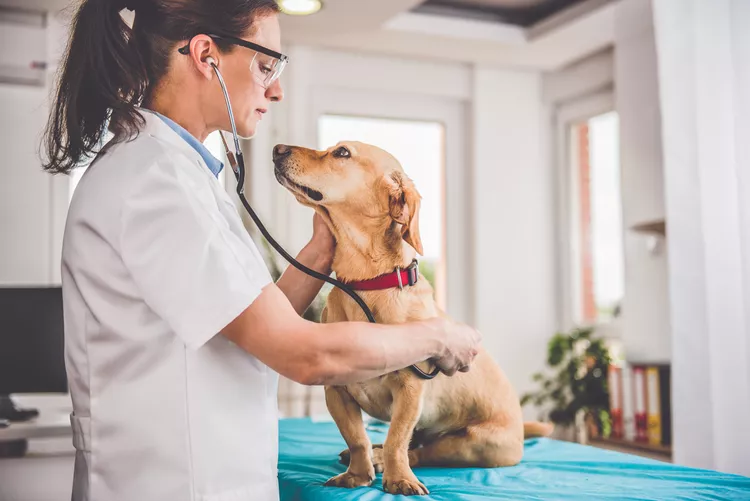- 01 of 13
Lumps and Bumps
Lumps, bumps, growths, masses, or tumors can appear anywhere on or inside the body. Some lumps and bumps are benign growths that appear as dogs age or due to genetics. Others may be cancerous and will require prompt medical attention to prevent metastasis (spreading).
See your vet if your dog develops new lumps, bumps, or areas of swelling. In addition, visit the vet if existing lumps or bumps change in shape or size, rupture, develop a discharge, or if they begin bothering your dog. Your veterinarian will examine your dog and run tests to pinpoint the type of growth present and determine if treatment is necessary.
- 02 of 13
Abdominal Swelling or Bloating
If your dog's abdomen looks enlarged or bloated, go to the vet as soon as possible. There are a few conditions that can cause the abdomen to become distended. A tumor in the abdomen may cause fluid buildup, enlarging the abdomen even if the tumor itself is still relatively small. Another potential cause is a deadly condition called GDV or "bloat."
- 03 of 13
Lethargy or Depression
When dogs are lethargic, depressed, or just "not right," it usually means something is wrong with their health. If it resolves on its own, then this is something to make a note of in case it recurs. If changes in activity level, mood, or behavior persist for a few days or are combined with other symptoms, you should contact the vet.
- 04 of 13
Weight Loss
Weight loss is a common sign of cancer in dogs, but there are a variety of health problems that can cause a dog to lose weight. Even a dog with a normal appetite may lose weight due to cancer or another illness. Talk to your vet if your dog seems to be losing weight (without trying).
Continue to 5 of 13 below - 05 of 13
Appetite Changes
A decrease in appetite often goes along with weight loss. However, some dogs might still eat fairly well and maintain weight but seem less enthusiastic about food or simply picky. Trouble eating or swallowing is also something to act upon. And any changes in thirst are noteworthy. Contact your vet if your dog's eating or drinking habits change, especially if it occurs in conjunction with other signs.
- 06 of 13
Vomiting or Diarrhea
Vomiting and diarrhea may occur for several reasons. While not always associated with cancer, they are things to address regardless of the cause. If vomiting or diarrhea persist and treatments for common causes don't work, your vet may recommend additional diagnostic tests to look for cancer or another disease.
- 07 of 13
Changes in Urination or Defecation
Cancer can affect both the urinary and digestive tract, causing changes in your dog's elimination habits. Contact your vet if you notice any changes, including:
- Difficulty urinating
- Lack of urination
- Constipation or straining to defecate
- Pooping or peeing in the house (if housetrained)
- Excessive amounts of pee or poop
- Blood in the urine
- 08 of 13
Lameness or Stiffness
Limping in dogs can be related to an injury, but if rest and medications do not make the problem go away, be sure to let your vet perform X-rays and other tests as indicated. Sudden limping with severe pain is always a cause for concern. Stiffness can also be a sign of a problem with muscles or bones. Bone cancer can cause either persistent or acute lameness, and diagnostic testing is needed to differentiate it from other chronic conditions, such as arthritis.
Continue to 9 of 13 below - 09 of 13
Pain or Discomfort
A dog in pain needs to see a vet as soon as possible. Cancer is a painful disease, but many other health conditions cause pain or discomfort. If your dog is in pain, you may notice that they sleep more and avoid socializing with people and pets in the household. They may try to avoid being touched, but not all dogs will vocalize their pain. A dog with abdominal pain may assume a hunched-over appearance and stop eating. Contact your vet if you think your dog is in any kind of pain or discomfort.
- 10 of 13
Exercise Intolerance
If your dog suddenly gets tired in the middle of a walk or playtime, there are numerous potential explanations. Cancer and many other illnesses may cause dogs to feel weak and tired. Although dogs may slow down as they age, sudden exercise intolerance is not normal and warrants a vet visit.
- 11 of 13
Abnormal Discharge or Bleeding
Blood or discharge from the skin, nose, mouth, eyes, ears, anus, or genitals are all reasons to see the vet right away. Potential causes of this can range from minor infections to major illnesses. Even if the reason is not cancer, it's an issue that needs attention.
- 12 of 13
Strong Odor
If you're smelling a strong odor coming from your dog and it wasn't there before, it means something is wrong. Strong odors may occur when tumors rupture or become infected.
Bad breath may be caused by dental problems, including oral tumors. Additional signs to look for include swelling in the face and apparent shifting of the teeth.
Odors from the rear end may be something minor like full anal glands, but the area should be examined. Look for swelling, bleeding, or discharge.
Continue to 13 of 13 below - 13 of 13
Abnormal Gum Color
A healthy dog's mucous membranes (gums, cheeks, insides of eyelids) and tongue should be nice and pink (black color from pigment is also normal). Pale, white, gray, or blue mucous membranes indicate a big problem.
Additionally, a yellow tinge to the mucous membranes, whites of the eyes, and or skin is indicative of jaundice that is typically seen with liver disease or disorders affecting red blood cells.




















